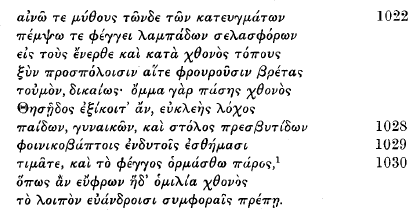Published online by Cambridge University Press: 23 December 2013
At the end of the play, when the Eumenides are to be ushered to their cave beneath the Areopagus, Athena joins to the procession a special escort of her own temple-servants, and sets forth the procession with these words:

The unsolved questions in lines 1028–1030 are two:—first, how to punctuate them, that is, who are to be the wearers of the crimson cloaks, the Escort or the Eumenides themselves: and second, what is the reason for the crimson colour? Neither question, perhaps, may seem to be of great importance; but Aeschylus is not a poet who does things at random; he is apt to have more than superficial meanings; and enquiry may, I hope, reward us with a new significance.
1 As I would read instead of πυρός: but this is immaterial here.
2 I have explained this much-mistaken phrase in the Classical Review, 1902, p. 435.
3 He supposes this to have heen an established piece of ritual, § 89: ‘In all probability there were also carved wooden images of the Erinyes here. For these images the purple robes were designed, which were consecrated to them upon the institution of their cultus by Athena.’
4 See e.g. Hermann, K. F.Alterthümer (1858) ii. pp. 139Google Scholar, 219, Lobeck, Aylaophamus p. 702Google Scholar.
5 Herman, K. F.Alterthümer (1858) ii. p. 219Google Scholar § 35 note 16 associates this as chthonic ritual with our passage.
6 Plut., Alcib. 22Google Scholarκαταρᾶσθαι προσεψηφίσαντο πάντας ἰερεῖς καὶ ἱερείας Max. Tyr. xii. 6 ἐπηρά σαντο αὐτῷ Κἡρυκες καὶ Εὐμολπίδαι
7 This is the significance of vv. 432–436.
8 This probably refers to the proverb συστομώτερον σκάφης Menand. Εὐνοῦχος
9 Michaelis, Parthenon p. 326Google Scholar (where the loci for the Panathenaea are quoted in full), Hermann, Alterthümer (1858) ii. p. 358–67Google Scholar, Mommsen, AugustFeste der Stadt Athen pp. 66, 101–4Google Scholar.
10 βᾶτ᾿ ἐν δὁμωι μεγἁλαι φιλότιμοι MS. Wellauer's reading, generally adopted, βᾶτε δὁμῳ is not Greek. Aeschylus—if he had tolerated such an ugly jumping rhythm—would have said βᾶτε δὁμον or δὁμους I believe that ᾿ Εργἀνη was a mistake for ![]()
![]() and that Aeschylus is using the same formula that Sophocles uses in setting forward a procession to Athena
and that Aeschylus is using the same formula that Sophocles uses in setting forward a procession to Athena ![]() (at the Χαλσεῖα also called ᾿ Αθήναια Mommsen, Feste p. 343Google Scholar) frag. 760: βᾶτ᾿ εἰς ὁδὸν δὴ πᾶς ὁ χειρῶναξ λεώς
(at the Χαλσεῖα also called ᾿ Αθήναια Mommsen, Feste p. 343Google Scholar) frag. 760: βᾶτ᾿ εἰς ὁδὸν δὴ πᾶς ὁ χειρῶναξ λεώς
11 My suspicion of the MS. προσώπων comes short of being certainty, but I am sure that my προσέρπον deserves more consideration than it has received. Latin, I know, often speaks of the Furiarum ora, but Greek here I feel should say, not from these dreadful visages, but from these dreadful-visaged Ones, ἐκ τῶν φοβερώπων τῶνδε or the like -φοβερῶπες is an epithet of theirs in Orph. hymn. 69, δεινῶπες O.C. 84, τὰς αἰματωποὺς καὶ δρακοντώδεις κόρας Eur., Or. 256Google Scholar, ἐκ τῶν φοβερῶν τῶνδε therefore should be from these dreadful creatures (φοβεραὶ κόραι they are called in Orph. h. 68), τῶνδε meaning the Erinyes themselves, as in 993, 973, 931, 936. If that is so, προσέρπον is exactly the word wanted, like καὶ σοὶ προσέρπον τοῦθ ὁρῶ in Aj. 1255: ἐρπω προσέρπω, ἐφέρπω were used especially of time coming on, or what time has in store. A participle is not indeed necessary with κέρδος ὁρω, but Heyse had already desiderated one, suggesting that after ὁρῶ we should read προσαπαντῆσον
12 All these references I owe to Mr. A. H. Cooke's article Metoeci in Smith's Dict. Ant.